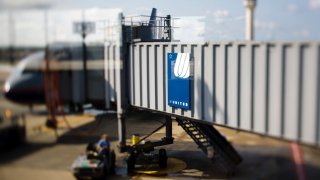
United Airlines economy passengers will soon be spared the awkward boarding “seat shuffle” of climbing over one another to get to their seats.
But those who prefer sitting near the aisle might need to be patient, as they’ll likely be among the last to be buckled into their seats.
Starting Oct. 26, the Chicago-based airline will reintroduce its boarding procedure known as WILMA — an acronym of sorts for window, middle, aisle — which United estimates will save about two minutes per flight, according to an internal memo.
Joe Leader, CEO of the Airline Passenger Experience Association, praised the plan for its “passenger-centric” approach to boarding.
“One of the most inefficient things on every aircraft is when you watch what I would call the ‘seat shuffle,’” Leader said. “It’s the least attractive aerial ballet on the planet. And I like anything that makes it simpler for customers.”
Under the system, passengers in first class, business class, exit rows and cardholders will see no changes. Preboarding passengers — which include those with disabilities and families with young children, among others — will also see no changes.
After these passengers have boarded, those with window seats will be allowed on the plane, followed by those with middle seats and then those with aisle seats. Finally, Basic Economy ticket holders will be the last to take their seats.
Local
Families and other passengers who book their tickets on the same reservation will be able to board together. In other words, if one member of a family has a window seat, they all board at the same time, even though some might have middle or aisle seats.
Leader said he expects the change will be well-received among travelers.
Feeling out of the loop? We'll catch you up on the Chicago news you need to know. Sign up for the weekly Chicago Catch-Up newsletter here.
United used WILMA broadly until 2017, but eliminated it when the airline introduced its Basic Economy option that year. Basic Economy restricts carry-ons. To accommodate the new class, the middle and aisle classes were condensed into the same boarding group, taking their seats at the same time, after passengers with window seats had boarded.
Maria Diaz, 28, said she likes the new process, but she predicts passengers who prefer aisle seats could be frustrated by overhead bin space running out.
Overall though, she said the switch makes sense.
“It is annoying if you’re sitting in the aisle, and you have to get out for the window person to come in,” Diaz said. “I think it could be beneficial.”
Her sister, Andrea Diaz, agreed that WILMA could help the boarding process flow better and ease awkwardness.
“It gets really uncomfortable if you’re in the window, and people are already seated in the aisle, you have to move them, and they have to stand up and let you go in,” she said.
Lynn Farrell, president of the travel agency Windy City Travel, said the new process sounds logical, and she doesn’t think it will significantly impact travelers.
She encouraged travelers concerned about overhead bin space to register with their airline’s frequent flyer program to enable them to board earlier.
“Everyone’s making a pretty big deal out of it, because it is a change,” Farrell said. “But I think at the end of the day, I don’t know that it will make boarding an aircraft an amazing experience. It is still going to be what it is.”
The reintroduced plan will be used on all domestic flights and some international flights.
If the new process goes well, Leader said other airlines may consider following suit, though some are committed to their own boarding procedures. As an example, he cited Southwest, which puts passengers into boarding groups but allows them to choose any open seat.



